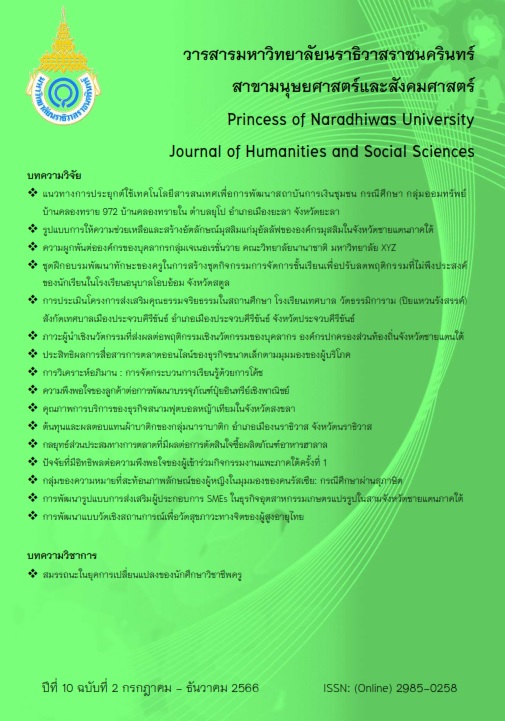Effects of Marketing Mix Strategies on Halal Food Purchasing Decisions
Main Article Content
Abstract
The purpose of this study was to investigate personal factors and marketing mix strategies that influence the purchasing decisions of Halal food products among Muslim consumers in Bangkok. The samples used in the study comprised of 400 Muslim consumers who purchased Halal food products in Bangkok. Convenience sampling was used, and a questionnaire was employed as the data collection instrument. The statistical methods used to analyze the data included frequency, percentage, mean, standard deviation, one – way ANOVA and multiple regression analysis.
The study results revealed that personal factors such as gender, age, occupation, education level, average monthly income, and the nature of being a Muslim have an effect on the purchasing decisions of Halal food products. Additionally, the tested hypotheses regarding the marketing mix strategies component indicated that three components, namely price, contribution channels, and promotion, have a moderately positive effect on the purchasing decisions of Halal food products, with statistical significance at the 0.05 level. However, the component namely, product, was found to have no significant effect on the purchasing decisions of Halal food products. These findings provide valuable insights for businesses to develop their products and offerings to meet the needs of Muslim consumers.
Article Details

This work is licensed under a Creative Commons Attribution-NonCommercial-NoDerivatives 4.0 International License.
References
ชัยสมพล ชาวประเสริฐ. (2547). การตลาดบริการ = Services marketing. กรุงเทพฯ: ซีเอ็ดยูเคชั่น.
ทัศนีย์ วงศ์สอน. (2562). ปัจจัยส่วนประสมทางการตลาดและพฤติกรรมของผู้บริโภคที่ส่งผลต่อการซื้อซ้ำผลิตภัณฑ์ผ้าฝ้ายทอมือของกลุ่มผ้าฝ้าย อำเภอจอมทอง จังหวัดเชียงใหม่ (การค้นคว้าอิสระบริหารธุรกิจมหาบัณฑิต). มหาวิทยาลัยราชภัฎเชียงใหม่, เชียงใหม่.
ธนาคารเพื่อการส่งออกและนำเข้าแห่งประเทศไทย. (2561). การส่งออกและนำเข้าอาหารฮาลาล. สืบค้นจาก https://www.ditp.go.th/contents_attach/709499/709499
ศุภร เสรีรัตน์ และศิริวรรณ เสรีรัตน์. (2541). นโยบายผลิตภัณฑ์และราคา. กรุงเทพฯ: ไทยวัฒนาพานิช.
สถาบันอาหาร กระทรวงอุตสาหกรรม. (2560). ช่องทางตรวจสอบและโปรโมทผลิตภัณฑ์ฮาลาล. สืบค้นจาก https://www.ryt9.com/s/prg/2759664
สํานักงานสถิติแห่งชาติ. (2561). สถิติศาสนาศิลปะวัฒนธรรม. สืบค้นจาก http://statbbi.nso.go.th/ staticreport/page/sector/th/04.aspx
สำนักงานมาตรฐานสินค้าเกษตรและอาหารแห่งชาติ. (2551). คำอธิบายพระราชบัญญัติมาตรฐานสินค้าเกษตร พ.ศ. 2551. สืบค้นจาก https://www.moac.go.th/law_agri-files-422891791101
Kotler, P. (1997). Marketing Management Analysis, Planning, Implementation and control (7thed.). illustrated: Prentice Hall.
Tolusic, K., Zmaic, K., & Deze, J. (2002). Marketing-mix in the function of the organic food of Eastern Croatia. Ekonomski Pregled, 53(7), 782-794.
Yooyen, A., & Leerattanakorn, N. (2012). Discovering Niche Market Consumer Preferences and Willingness to Pay for Organic Pork. Chinese Business Review, 11(3), 251-264.


